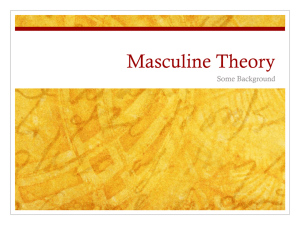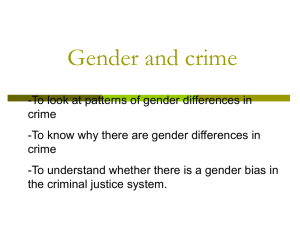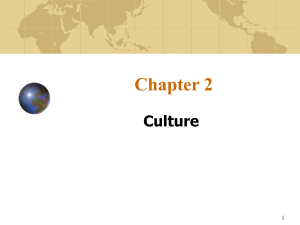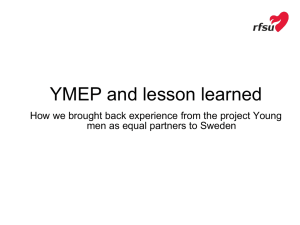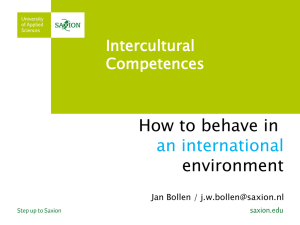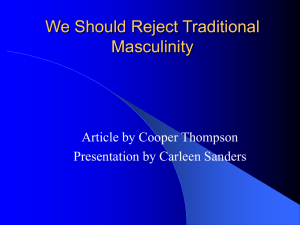A Perspective on the Anthropology of Masculinity 10102013
advertisement
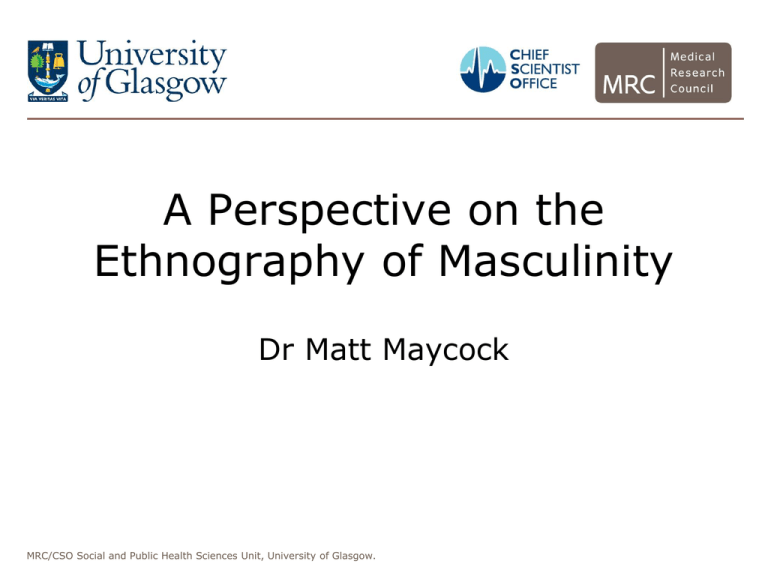
A Perspective on the Ethnography of Masculinity Dr Matt Maycock MRC/CSO Social and Public Health Sciences Unit, University of Glasgow. Structure • Introduction • Historical context – Anthropology of men • Anthropology Vs Ethnography of masculinity • The ‘ethnographic moment’ in men and masculinity studies • Methods • Influence on my research • References MRC/CSO Social and Public Health Sciences Unit, University of Glasgow. Historical Context Men and the ‘Anthropological record’: • Men ‘unmarked’ and were the norm upon which knowledge about a specific society was build on. • The various differences and divisions between men and women were viewed as ‘natural’ • Men are [overly] present but not explicitly so. • The gendered experiences and subjectivities of men were not considered • The influence of the gendered identity of the person/s doing the research was largely not considered. Anthropology was/is for my and by men (Guttman) MRC/CSO Social and Public Health Sciences Unit, University of Glasgow. Anthropology Vs Ethnography According to Radcliff-Brown, 1965 (Structure and Function in a Primitive Society), the difference between anthropology and ethnography is the difference between idiographic and nomothetic inquiry. Radcliff-Brown explains that: • • An idiographic inquiry [ethnography] aims to document the particular facts of past and present lives While the aims of nomothetic inquiry [anthropology] is to arrive at general propositions of theoretical statements. Anthropologies of Masculinity For example, Gilmore, 1990 (Manhood in the Making: Cultural Concepts of Masculinity) presents a cross-cultural comparative collection of anthropological work exploring with cultural conceptions of manhood. He deals with the question of what a “real man” is through a sampling of various cultures. There are several problems with this: This homogenises masculinity This is descriptive and not analytical Gilmore points towards a universal definition of masculinity, defined in opposition to MRC/CSOfemininity. Social and Public Health Sciences Unit, University of Glasgow. • • • The emergence of Ethnographies of masculinity • Feminist anthropology examined social inequality and the nature of women’s disempowerment. • Masculinity tended to be overlooked in this work on ‘gender’. • To better understand gender generally and men’s gendered experiences specifically, recently some explicit focus has been placed on studying masculinity/s within Ethnography. • This is part of a wider trend in which masculinities are being examined within gender studies as a specific area of concern. • This ‘area’ of research centrally argues that masculinities are a valid and vital area of study within ethnography and that explicitly studying masculinities enriches studies of gender more broadly. MRC/CSO Social and Public Health Sciences Unit, University of Glasgow. The ‘Ethnographic Turn’ in Masculinity Studies “…men do masculinity according to the social situation in which they find themselves.” (Messerschmidt, 1993, 84) In Masculinities (1995, 2005 ), Raewyn Connell talks about a ethnographic turn in masculinity studies, what does she mean by this? Ethnographic studies of masculinity tend to: • Assume masculinities are multiple (both locally and globally). • Unpack the ways in which masculinities are socially and culturally constructed and performed. • Examine how masculinities impact on each other. • Examine the ways in which masculinity is constructed in relation to subordinate women and femininities. • Be ‘micro’ level in focus. • Undertaken in both urban and rural contexts. • Consider ‘positive’ masculinities and subvert the idea of men as a [or the] problem. MRC/CSO Social and Public Health Sciences Unit, University of Glasgow. The achievements of the ‘Ethnographic Turn’ in Masculinity Studies Ethnographic studies of masculinity have: • Illustrated the cross-cultural variance in performances and modes of masculinity. • Proven that there is no single masculinity. • Showed that masculinities can and do change. This was important in overcoming the tendency in the mass media and popular culture to treat ‘men’ as a homogenous group ‘masculinity’ as a fixed, ahistorical entity. • Identified the importance of intersectionality of gender with class, caste, race, ethnicity, sexuality, age etc… • Consolidated men and masculinities as a world-wide field of knowledge. • A significant amount of the research at the beginnings of this turn focused on discourses of hegemonic and subordinate masculinities (following Connell). • More recently a number of studies have focused more on intricate studies of social practice, with a focus on ambiguity and context specific performances of masculinity. • Collections of micro-research and applied studies of masculinity exist for practically every continent or culture-area. MRC/CSO Social and Public Health Sciences Unit, University of Glasgow. Ethnographic Methods What can ethnography contribute to studies of masculinity from a methodological perspective? • Participant observation and masculinity. • The locatedness of research and micro level research/richness • Gender and epistemology “the ways in which gender intervenes to block the process of knowing about the construction of knowledge” (Chopra 2004: 37). • Masculinity and positionality – the narcissistic turn in ethnography (Chopra, 2004) • Problems (alongside various issues with ethnography more generally): • • Time Theory derived from ‘Developed’ contexts applied within ‘Developing’ contexts MRC/CSO Social and Public Health Sciences Unit, University of Glasgow. How has this shaped my research? Until recently masculinity has not received significant attention in South Asia, despite the gender ‘awareness’ of the NGO and academic sectors in the region: “For a long time, South Asian men have been treated as universally given, ungendered objects and have rarely been examined as gendered.” (Sharma, 2007a: 33) My thesis examines the ways in which poor, subaltern men perform masculinities that respond to a fluid framework of masculine references. More specifically I examined, consumption, embodiment, labour, movement, literacy and marriage. I lived in a village for a year and have been visiting Nepal for over 15 years. There is an unresolved tension between [western] theories of masculinity and local performances I was studying. I am still unclear of the utility of of MRC/CSO Social and Public Health Sciences Unit, University of Glasgow. hegemonic masculinity within ethnographic research on masculinity. Questions/ Comments MRC/CSO Social and Public Health Sciences Unit, University of Glasgow. References • • • • • • • • • • • • • • • • Almeida, M. 1996. The Hegemonic Male: Masculinity in a Portuguese Town, London, Berghahn. Beasley, C. 2008. Rethinking Hegemonic Masculinity in a Globalizing World. Men and Masculinities, 11, 86-103. Chopra, R. 2004. Encountering Masculinity: An ethnographer’s dilemma. In: CHOPRA, R., OSELLA, C. & OSELLA, F. (eds.) South Asian masculinities : context of change, sites of continuity. New Delhi: Kali for Women. Chopra, R., Osella, C. & Osella, F. 2004. South Asian masculinities : context of change, sites of continuity, New Delhi, Women Unlimited an associate of Kali for Women. Cleaver, F. 2002. Masculinities matter! : men, gender, and development, London ; New York, Zed Books. Connell, R. W. 2005. Masculinities Cambridge, Policy Press. Cornwall, A., EdstrèOm, J. & Greig, A. 2011. Men and development: politicizing masculinities, London, Macmillan. Cornwall, A. & Lindisfarne, N. 1994. Dislocating masculinity: comparative ethnographies, London, Routledge. CORREIA, M. C. B., I (ed.) The Other Half of Gender. Washington: World Bank. Gilmore, D. D. 1990. Manhood in the making : cultural concepts of masculinity. Conn, Yale University Press. Gutmann, M. C. 1997. Trafficking in Men: The Anthropology of Masculinity. Annual Review of Anthropology, 26, 385-409. Maycock, M. 2012. Masculinity, Modernity and Bonded Labour: Continuity and Change amongst the Kamaiya of Kailali District, far-west Nepal. Doctor of Philosophy, University of East Anglia. Morrell, R. & Swart, S. 2005. Men in the Third World, Postcolonial Perspectives on Masculinity. In: KIMMEL, M. S., HEARN, J. & CONNELL, R. (eds.) Handbook of studies on men & masculinities. London: Sage Publications. Osella, F. & Osella, C. 2000. Migration, Money and Masculinity in Kerala. Journal of Royal Anthropological Institute, 6, 117-133. Srivastava, S. 2004. Sexual sites, seminal attitudes: sexualities, masculinities, and culture in South Asia. London, Sage. Masculinity in a Global Perspective: http://gencen.isp.msu.edu/publications/b_masculinity.htm MRC/CSO Social and Public Health Sciences Unit, University of Glasgow.

